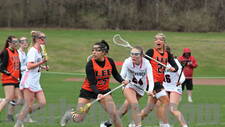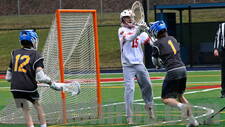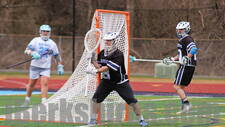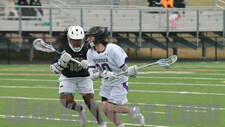Friday Health Focus: Crisis Planning At Center StageBy Susan Bush
12:00AM / Friday, March 10, 2006
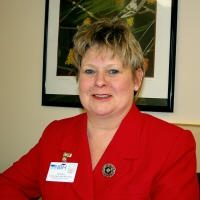 | | Susan Gancarz, NARH Director of Quality and Infection Control |
The possible catastrophic scenarios facing medical facilities at a national, state, and regional level are endless.
An influenza pandemic, possibly involving the avian flu, could generate a sudden patient influx or "surge" at Berkshire hospitals. Terrorist attacks, chemical spills, or natural disasters could drop chaotic crisis at the feet of medical and emergency services personnel. Situations could occur separately, or simultaneously.
Throughout the region, the state, and the country, plans are being developed, training sessions and drills are occurring, and public and private entities are working together to prepare for worst-case scenarios.
"No one can be complacent," said Northern Berkshire Healthcare Community Relations Director Paul Hopkins.
Regional Response

Kathy Arabia, chairwoman of the NARH Safety Committee and Director of Guest Services |
In the Berkshires, the Western Mass. Hospital Emergency Planning Group has been active since soon after Sept. 11, 2001. The group includes North Adams Regional Hospital in North Adams, Berkshire Medical Center in Pittsfield, and Fairview Hospital in Great Barrington.
The planning group's efforts are not limited to pandemics and potential consequences associated with outbreaks of illness but includes response planning for all types of emergency situation, said Kathy Arabia, the chairwoman of the NARH Safety Committee and director of guest services, and NARH Director of Quality and Infection Control Susan Gancarz. The group works with an eye toward regional cooperation and support, she said.
Prior to Sept. 11, 2001, most emergency preparedness and response training involved localized scenarios such as bus crashes with multiple injuries, Arabia and Gancarz said.
Since Sept. 11, trainings and drills occur with guidance and support from various contingents within the state Department of Public Health, and focus on very serious situations that could generate a host of complications and casualties. For example, drills can include scenarios that involve illness outbreaks coupled with power outages, Gancarz and Arabia said.
"What we do as a region is work on increasing our ability to respond to emergencies in our communities, and ways to support our region," Arabia said.
Trainings frequently involve establishing and working with an incident command system that is a component of the national Department of Homeland Security.
Preparedness
Hospitals are assembling databases that include lists of qualified medical and emergency services workers that can be accessed during times of crisis. The databases mean that a list of crucial personnel is at hand and personnel may be shared throughout the region or the state if necessary, Arabia said. The NARH list contains 125 people, she said. Lists of qualified volunteers who reside within specific regions are also being assembled.
"We are training all emergency responders at this hospital in this protocol," she said, and added that police officers and firefighters are among those required to utilize the protocol as well. Trained hazardous materials teams already operate using an incident command system, she said.
Hospital employee trainings also include proper use of personal protective equipment; on March 9, specific NARH staff members were participating at an on-site "PPE" training. The protective clothing used during the training was identified as "Level C" suits and included externally-attached purified air breathing equipment, full-coverage headgear, body-covering suits, and layers of gloves and boots. Decontamination training was part of the day's training session.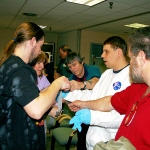
NARH employee Bruce Polumbo is assisted while donning protective clothing during a March 9 hospital training session. |
Earlier this week, members of the Berkshire County Health Association met and pandemic preparedness was among the issues discussed, Arabia said.
Those participating with the extensive trainings are very cooperative, Gancarz said.
"They find the sessions very informative," she said. "They become confident that we are organized and that they can handle [various crisis situations]."
State Focus On "Pandemic Planning"
Gov. Mitt Romney has released a multi-page document titled "Pandemic Planning" that divides the state into several regions. The Western Massachusetts region is identified as R-1.
A chain of responsibility has been established as follows: "Localities should turn to regions first for assistance, Regions will turn to surrounding regions and the State, the State will turn to the Federal government when our resources are exceeded."
The plan calls for funding legislation that would support implementation of actions and support frameworks. Regional "summits" are planned for April state-wide, according to the state pandemic planning document, and additional state actions include a schedule of summertime tests that will assess preparedness plans and identify any gaps pr problems.
State officials have prepared Continuity of Operations [COOP] plans and Continuity of Government [COG] plans for all state agencies, and medical facilities such as hospitals are being required to develop COOPs by the state Department of Public Health. Emergency plans already in place at NARH were incorporated into a hospital COOP, said Arabia.
"The COOP integrated into emergency plans we already have," she said. "We went through and identified how we would continue to operate in this difficult situation."
The state pandemic planning document identifies hospital/patient surge capacity as a critical area. Four levels of patient surge have been identified, with level 1 designated as the least urgent and level four, which describes overflow patients placed in beds stationed in "non-traditional care areas" such as lobbies and cafeterias, the most urgent. The Western Mass. region is equipped with more overflow bed capacity than other state regions but a Level Four situation would present challenges, Arabia said.
"There is no doubt we'd be stressed at a Level Four," she said.
Citizen Actions
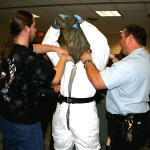
Donning headgear can be a two-person task. |
The state's plan lists steps that the public can take toward protecting themselves and others in a pandemic situation.
In addition to thorough and frequent handwashing, the plan asks that children be taught effective handwashing skills, urges use of antibacterial hand cleansers, asks that people remain home from school or work if ill, suggests keeping a three-foot distance between oneself and anyone coughing or sneezing, getting a flu shot and, if physician-recommended, a pneumonia shot, maintaining a 30-day supply of canned and dried foods in the home, talking with prescribing physicians about having over a 30-day supply of medications, and reviewing a "Pandemic Influenza Guide for Individuals and Families," which is available at a www.pandemicflu.gov web site.
Difficult Decisions
In the event of a pandemic, hospital ethics commissions would become very involved in any response as health care workers would need an established protocol for delivery of services, Gancarz said.
For example, smaller hospitals would likely have limited numbers of items such as ventilators to aid with breathing; a protocol may be put into place about who would receive ventilator services.
"These are the kinds of very difficult decisions that would have to be made," Gancarz said.
Avian Flu Concerns and Updates
While a pandemic could involve any number of illnesses, officials of the Center for Disease Control and Prevention and the international World Health Organization are closely monitoring the avian flu.
No human cases of the deadly virus have been reported in the United States, Canada, or Mexico as of March 9. Since 2003, 175 human cases have been confirmed in seven countries, including Cambodia, China,Iraq and Thailand; 96 people have died of the illness.
The avian flu is caused by "influenza a" avian viruses that occur naturally among birds, according to information available at the www.pandemicflu.gov web site. While wild birds may carry the virus without becoming ill, the viruses are considered very contagious and can make domesticated birds such as chickens, ducks, and turkeys very ill and cause death.
The current virus causing concern among health officials internationally is identified as the H5N1 subtype.
"H5N1 is one of the few avian influenza viruses to have crossed the species barrier to infect humans," states information at the pandemic web site.
The information also states "So far, the spread of the H5N1 virus from person to person has been limited and has not continued beyond one person. Nonetheless, because all influenza viruses have the ability to change, scientists are concerned that H5N1 virus one day could be able to infect humans and spread easily from one person to another."
The virus is infecting some mammal species, according to information available on the World Health Organization web site.
On March 9, German officials confirmed that H5N1 was found in a very ill stone marten, a nocturnal mammal with feeding habits similar to cats. Also in Germany, three domestic cats were found infected with the virus.
"Further investigation is needed to determine whether evidence of H5N1 infection in new mammalian species has any significance for the risk of human infection or the potential of this virus to adapt to mammals, including humans," information posted at the site states.
Conditions That May Create A Pandemic
According to the CDC, three conditions must be present to create an avian flu pandemic. Two conditions, a new influenza subtype and an ability to infect humans and cause serious illness, have already occurred. A third condition, the establishment of efficient and sustained human-to-human transfer of the virus, has not occurred, according to information made available by the CDC.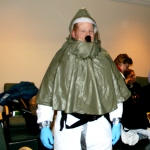
Andy Foucher is completely covered by the protective clothing. |
In the event of a pandemic involving any illness, medical triage arenas would likely be established away from hospitals and emergency rooms, said Arabia and Gancarz. Separate triage areas would keep people ill with contagious disease away from people who are uninfected, and allow for more focused treatment.
Infection control policies and procedures would be implemented as well as diagnostic and communication protocols, Gancarz said. Recent public health service training sessions involved scenarios and responses affiliated with illnesses such as anthrax, and the comments from state officials were reassuring, said Arabia and Gancarz.
"They had some very nice things to say about us," said Arabia.
Funding
Funding to support training sessions, establishment of response protocols and necessary medical equipment has come from the Department of Homeland Security and other sources, Gancarz said.
In January, U.S. Department of Health and Human Services Director Michael Leavitt announced $100 million in funding was being made available to assist state and local pandemic influenza preparedness efforts. Massachusetts was in line to receive $2,061,287 during the revenue distribution's Phase 1, according to information provided by the Department of Health and Human Services.
Revenues have paid for items such as portable stretchers, HEPA filters, and other medical equipment, said Gancarz.
And while the education and trainings are very much focused on worst-case scenarios, most medical and emergency personnel are hopeful that the most catastrophic situations will be avoided. But should a crisis unfold, medical responses are likely to be rapid and efficient, said Arabia.
"I feel very good about where we are," she said. "There is always more that we can do but over the past couple of years, we have integrated very much with the Department of Public Health."
Additional information about pandemics and the avian flu is available a Center for Disease Control and Prevention www.cdc.gov web site, a www.avianflu.gov web site, and a www.pandemicflu.gov web site.
Information is also offered at the World health Organization's www.who.int web site and a Department of Health and Human Services www.hhs.gov web site.
The Massachusetts Department of Public Health may be accessed via a www.mass.gov web site.
Susan Bush may be reached via e-mail at suebush@iberkshires.com or at 802-823-9367.
|















